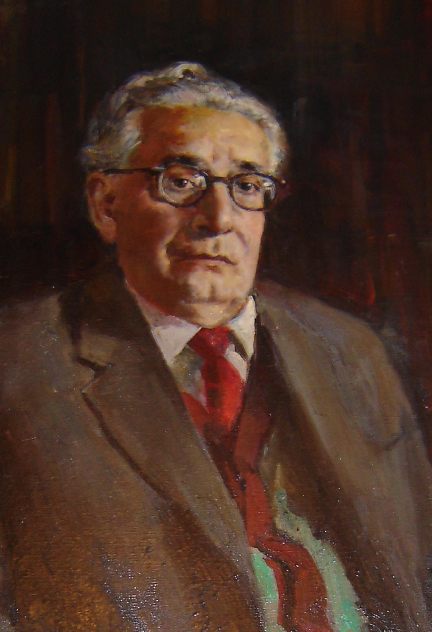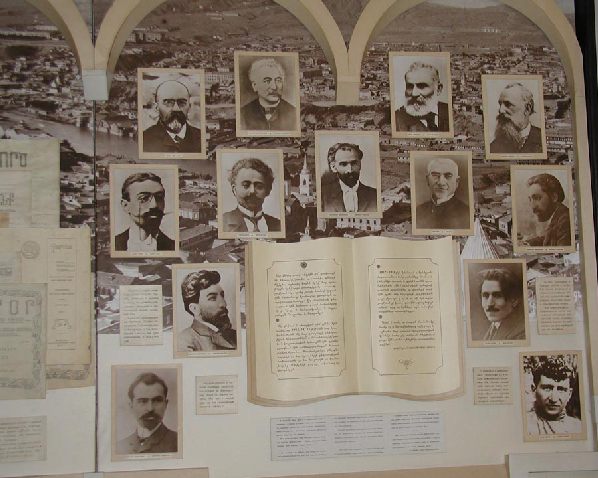
by Dmitri Nalbandian
(© R. Bedevian/Groong)
Armenian News Network / Groong
December 6, 2004
Travel Wire
By Ruth Bedevian
VANADZOR, ARMENIA
I was warmly remembered by Razmig Boghosian, Director of the Stepan Zoryan House Museum and a member of the Union of Armenian Writers, and Juliette Yeghayan, former director (1981-1992), as I stepped into the foyer of the museum at 24 Stepan Zoryan Street, Vanadzor, Armenia. It is a beautiful pink stone (tufa) house with an inviting courtyard adorned with apple trees, rose bushes and a bust of the writer by sculptor Marat Minasyan. During my June visit, I had very little time to tour the museum and had promised to return and return I did on November 10, 2004.
One of the best-kept of the House Museums in Armenia, it was listed among cultural establishments since 1981, but the official opening took place on September 15, 1990, to celebrate the 100th anniversary of the writer's birth. Zoryan had lived in the house in the summer and fall seasons from 1964 - 1967, enjoying the fresh breezes and peaceful ambience of this enchanting setting. Following his demise in 1967, Zoryan's architect sons renovated the home, adding one more floor.
The first floor depicts old Kharakilisa (Invading Turks burned the city and the name emerged, `Black Church.' The name subsequently changed to Kirovakan under the Soviets and since Independence it has been renamed - Vanadzor). The writer's study is also located on the ground floor which opens to a pleasant view of the courtyard. A small bedroom that he used is also on display. Juliette pointed to a podium standing in the corner of the study and remarked, `Like Hemingway, Zoryan also liked to stand while writing!'
With only one hour on a hectic schedule, I asked to begin our tour of the second floor which contains the writer's work in Tbilisi, Yerevan and Vanadzor. Filled with photographs and memorabilia that not only chronicles the life events of its namesake, but yields information and photos of Zoryan's contemporaries and colleagues - Derenik Demirdjian, Avetik Isahakyan, Yeghishe Charentz, Baruyr Sevag, Aksel Bakuntz, etc. The room is large, airy and well-groomed. My guides began to educate me about the former resident of this charming house. `Born Stepan Yeghia Arakelian in 1889, Zoryan tried twice to enter the prestigious Nersisian school in Tbilisi, but was turned down because he knew only two languages, Armenian and Russian,' related Boghosian and Yeghayan. A large display contains original copies of the papers to which he contributed including Mshag, (Workers), Surhandag (Courier), Pakouhi Dzayn, Areg, Chatabalada, etc. His first poem was published in `Luma,' entitled `Starving People.' As a budding writer in Tbilisi he became acquainted with Hovhannes Toumanyan and helped organize the Caucasian Union of Armenian Writers. Largely self educated, he rose to become an editorial assistant and an accomplished translator.

|
|
Zoryan Portrait by Dmitri Nalbandian (© R. Bedevian/Groong) |

|
|
Wall of Colleagues (© R. Bedevian/Groong) |
A great admirer of Russian writers (especially Chekov), he translated into Armenian from Russian the trilogy of Leo Tolstoy's War and Peace. The highly educated and talented Vahan Terian had begun the translation of the first volume, but succumbed to tuberculosis at the untimely age of 35 before the greater part of the task could be finished. Boghosian proudly remarked, `With Terian's blessings Zoryan accomplished this great service, rendering the works of great writers that widened the horizons of the Armenian people.' An annual prize for translations from or into Armenian was established in Zoryan's name in 1980. It is noteworthy to quote Kevork B. Bardakjian here, `Literatures of the peoples of the Soviet Union especially Russian, were rendered into Armenian, and Armenian literature was made available to a much wider audience through translations into Russian. As for Western literature, thought, and culture in general, Moscow was the sole arbiter; it selected and disseminated what it saw fit. For many long decades, Western literature was rendered into Armenian from Russian translations.' [A Reference Guide to Modern Armenian Literature 1500-1920 page 203.]
When Soviet restrictions on literature were eased during World War II to bolster patriotism to fight against Nazi Germany, Zoryan as well as his good friend and colleague, Derenik Demirdjian, seized the window of opportunity to write historical novels. Zoryan is best remembered for his trilogy King Pap (1944) which was followed by The Fortress of Armenia (1960) and then Varazdat (1967).
A partial list of Zoryan's works are: The Starving Ones, in 1909; Sad Men (1918) ; Fence in 1923; War in 1925 ; `The President of the Revolutionary Committee' and `The Girl in the Library' in 1926. The Simple Souls in 1945. The Story of a Life, which was published in two volumes between 1935 and 1939, is akin to David Copperfield according to Eddie Arnavoudian, literary commentator for Groong's Critical Corner, `Like David Copperfield, it (The Story of a Life) encompasses the same elements of childhood, adventure, mystery, wit, and coming of age.' The Amira's Family (1963), was his last novel.
In parting, I reminded my tour guides that I was given a rose from the garden in June which I had pressed and preserved as a remembrance. `Ah! Madam,' Boghosian sighed, `I deeply regret that I have not a rose to give you; it is not the season.' `Never you mind,' I responded, `I am leaving with memories that will stay fresh and be shared, not like roses that will dry out and die.'
|
Redistribution of Groong articles, such as this one, to any other
media, including but not limited to other mailing lists and Usenet
bulletin boards, is strictly prohibited without prior written
consent from Groong's Administrator. © Copyright 2004 Armenian News Network/Groong. All Rights Reserved. |
|---|